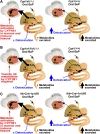Oral benzo[a]pyrene: understanding pharmacokinetics, detoxication, and consequences--Cyp1 knockout mouse lines as a paradigm
- PMID: 23761301
- PMCID: PMC3876811
- DOI: 10.1124/mol.113.086637
Oral benzo[a]pyrene: understanding pharmacokinetics, detoxication, and consequences--Cyp1 knockout mouse lines as a paradigm
Abstract
Benzo[a]pyrene (BaP) is a prototypical polycyclic aromatic hydrocarbon (PAH); this ubiquitous environmental carcinogenic agent is found in tobacco smoke, charcoal-grilled foods, and PAH-contaminated surfaces of roofs, playgrounds, and highways. Cytochrome P450 1 wild-type, Cyp1a2(-/-), Cyp1b1(-/-), or Cyp1a2/1b1(-/-) knockouts, and mice with Cyp1a1 expression deleted in hepatocytes can ingest large oral BaP doses (125 mg/kg/d) without apparent toxicity. Cyp1a1(-/-) and Cyp1a1/1a2(-/-) knockouts and mice with Cyp1a1 expression deleted in gastrointestinal (GI) tract epithelial cells develop immunotoxicity and die within 32 days, indicating that GI tract inducible CYP1A1 is absolutely required for detoxication of oral BaP. Cyp1a1/1b1(-/-) and Cyp1a1/1a2/1b1(-/-) mice are rescued from immunosuppression and early death due to absent metabolic activation of BaP by CYP1B1 in immune cells. Ten-fold lower oral BaP doses result in adenocarcinoma of the proximal small intestine (PSI) in Cyp1a1(-/-) mice; Cyp1a1/1b1(-/-) double-knockout mice show no PSI cancer but develop squamous cell carcinoma of the preputial gland duct (PGD). BaP-metabolizing CYP1B1 in the PSI and CYP3A59 in the PGD are the most likely candidates to participate in tumor initiation in the epithelial cells of these two tissues; oncogenes and tumor-suppressor genes upregulated and downregulated during tumorigenesis are completely different between these tissues. This "oral BaP Cyp1" mouse paradigm represents a powerful teaching tool, showing that gene-environment interactions depend on route-of-administration: the same oral, but not intraperitoneal, BaP exposure leads to dramatic differences in target-organ toxicity and tumor type as a function of dose and Cyp1 genotype.
Figures


Similar articles
-
Oral benzo[a]pyrene-induced cancer: two distinct types in different target organs depend on the mouse Cyp1 genotype.Int J Cancer. 2010 Nov 15;127(10):2334-50. doi: 10.1002/ijc.25222. Int J Cancer. 2010. PMID: 20127859 Free PMC article.
-
Oral benzo[a]pyrene in Cyp1a1/1b1(-/-) double-knockout mice: Microarray analysis during squamous cell carcinoma formation in preputial gland duct.Int J Cancer. 2013 May 1;132(9):2065-75. doi: 10.1002/ijc.27897. Epub 2012 Dec 4. Int J Cancer. 2013. PMID: 23047765
-
Oral benzo[a]pyrene in Cyp1 knockout mouse lines: CYP1A1 important in detoxication, CYP1B1 metabolism required for immune damage independent of total-body burden and clearance rate.Mol Pharmacol. 2006 Apr;69(4):1103-14. doi: 10.1124/mol.105.021501. Epub 2005 Dec 23. Mol Pharmacol. 2006. PMID: 16377763
-
Metabolic activation of polycyclic aromatic hydrocarbons to carcinogens by cytochromes P450 1A1 and 1B1.Cancer Sci. 2004 Jan;95(1):1-6. doi: 10.1111/j.1349-7006.2004.tb03162.x. Cancer Sci. 2004. PMID: 14720319 Free PMC article. Review.
-
The role of trace metals in cytochrome P4501 regulation.Drug Metab Rev. 2006;38(1-2):227-34. doi: 10.1080/03602530600570073. Drug Metab Rev. 2006. PMID: 16684659 Review.
Cited by
-
Benzo[a]pyrene-Environmental Occurrence, Human Exposure, and Mechanisms of Toxicity.Int J Mol Sci. 2022 Jun 6;23(11):6348. doi: 10.3390/ijms23116348. Int J Mol Sci. 2022. PMID: 35683027 Free PMC article. Review.
-
The complexity of the Nrf2 pathway: beyond the antioxidant response.J Nutr Biochem. 2015 Dec;26(12):1401-13. doi: 10.1016/j.jnutbio.2015.08.001. Epub 2015 Aug 8. J Nutr Biochem. 2015. PMID: 26419687 Free PMC article. Review.
-
PAHs Target Hematopoietic Linages in Bone Marrow through Cyp1b1 Primarily in Mesenchymal Stromal Cells but Not AhR: A Reconstituted In Vitro Model.Stem Cells Int. 2016;2016:1753491. doi: 10.1155/2016/1753491. Epub 2016 Nov 7. Stem Cells Int. 2016. PMID: 27891153 Free PMC article.
-
Molecular mechanisms of pulmonary carcinogenesis by polycyclic aromatic hydrocarbons (PAHs): Implications for human lung cancer.Semin Cancer Biol. 2021 Nov;76:3-16. doi: 10.1016/j.semcancer.2021.07.001. Epub 2021 Jul 7. Semin Cancer Biol. 2021. PMID: 34242741 Free PMC article. Review.
-
Evolution of Hominin Detoxification: Neanderthal and Modern Human Ah Receptor Respond Similarly to TCDD.Mol Biol Evol. 2021 Apr 13;38(4):1292-1305. doi: 10.1093/molbev/msaa287. Mol Biol Evol. 2021. PMID: 33230523 Free PMC article.
References
-
- Alvares AP, Kappas A, Levin W, Conney AH. (1973) Inducibility of benzo(a)pyrene hydroxylase in human skin by polycylic hydrocarbons. Clin Pharmacol Ther 14:30–40 - PubMed
-
- Alvares AP, Schilling G, Levin W, Kuntzman R. (1967) Studies on the induction of CO-binding pigments in liver microsomes by phenobarbital and 3-methylcholanthrene. Biochem Biophys Res Commun 29:521–526 - PubMed
-
- Anderson KE, Kadlubar FF, Kulldorff M, Harnack L, Gross M, Lang NP, Barber C, Rothman N, Sinha R. (2005) Dietary intake of heterocyclic amines and benzo(a)pyrene: associations with pancreatic cancer. Cancer Epidemiol Biomarkers Prev 14:2261–2265 - PubMed
-
- Baer C, Claus R, Plass C. (2013) Genome-wide epigenetic regulation of miRNAs in cancer. Cancer Res 73:473–477 - PubMed
-
- Bauer E, Guo Z, Ueng YF, Bell LC, Zeldin D, Guengerich FP. (1995) Oxidation of benzo[a]pyrene by recombinant human cytochrome P450 enzymes. Chem Res Toxicol 8:136–142 - PubMed
Publication types
MeSH terms
Substances
Grants and funding
LinkOut - more resources
Full Text Sources
Other Literature Sources
Miscellaneous

